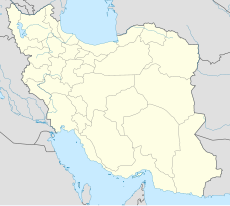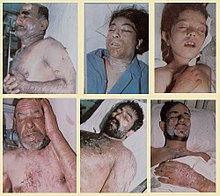Poison gas attack on Sardinia
The poison gas attack on Sardasht on June 28, 1987, the first major attack by Iraq with chemical weapons on an Iranian city during the first Gulf War . The attack only became known to the world as a result of the poison gas attack on Halabja .
prehistory
On April 13, 1987, the Kurdish rebels of the Patriotic Union of Kurdistan, together with regular units of the Iranian army in operation "Kerbala 9" , launched attacks against strategic points of the Iraqi army in the area around Sulaimaniyya . Two days later, the Iraqi air force responded with poison gas attacks on 20 Kurdish villages, including on April 15, 1987 at 7:00 p.m. against the Iranian city of Sardasht (internationally also Sardasht ) with 12,000 inhabitants. 60 people were injured in Sardashht. On June 27, 1987, during Operation Kerbala 10, the Iraqi city of Qalat Dizah was attacked by Kurdish rebels.
attack
On June 28, 1987 at 4:04 p.m., the Iraqi air force dropped four 250 kg bombs with mustard gas over the Iranian city of Sardasht in two attack flights. Over the years, over 100 Iranians have died from the poison gas.
Initial reports spoke of 10 killed and 650 injured. The number of fatalities rose to 12 within 24 hours, 35 after a week and 60 killed and 2,000 injured after a month. Foreign journalists were brought to Sardinia on July 29th to cover it. Some of the injured were flown to Brussels, Madrid, Rome and Vienna for treatment; the UN has pictures.
Even after the poison gas attack of June 28, 1987, Sardasht was shot at with chemical artillery ammunition on January 11, 1988, and suburbs were hit by Sardasht on March 28, 1988.
Medical studies
More than 20 years apart, the long-term effects of the effects of mustard gas were examined in two studies with poison gas victims from Sardashht. A total of 500 mustard gas victims, 372 of which were poison gas victims from Sardasht, were compared with an unaffected control group in order to gain information on diagnosis, treatment and prevention of the long-term effects of mustard gas exposure. Another study examined the health of 260 war veterans from Sardasht who had been injured by mustard gas.
Individual evidence
- ^ Dilip Hiro: The Longest War . The Iran-Iraq Military Conflict. New York: Routledge Chapman & Hall, Inc., 1991, ISBN 0-415-90407-2 , p. 185
- ↑ Iran supports campaign for total eradication of chemical weapons ( Memento from September 1, 2015 in the Internet Archive )
- ^ Iraq and Chemical & Biological Warfare. In: cbw-events.org.uk 87/02, accessed on January 15, 2013 (PDF; 58 kB)
- ^ Iraq and Chemical & Biological Warfare. In: cbw-events.org.uk 88/01, accessed on January 15, 2013 (PDF; 89 kB)
- ↑ Sardasht-Iran cohort study of chemical warfare victims: design and methods. Arch Iran Med. 2009; 12 (1): 5-14, PMID 19111023 .
- ↑ M. Abbasi et al .: Quality of Life of Chemically-Disabled War Veterans Involved in Pulmonary Complications of Sulfur Mustard Gas in Sardasht Qom Univ Med Sci J 2012; 5 (4): 34-39

